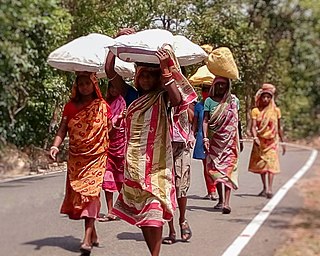Related Research Articles

Santali, also known as Santal or Santhali, is the most widely-spoken language of the Munda subfamily of the Austroasiatic languages, related to Ho and Mundari, spoken mainly in the Indian states of Assam, Bihar, Jharkhand, Mizoram, Odisha, Tripura and West Bengal by Santals. It is a recognised regional language of India as per the Eighth Schedule of the Indian Constitution. It is spoken by around 7.6 million people in India, Bangladesh, Bhutan and Nepal, making it the third most-spoken Austroasiatic language after Vietnamese and Khmer.

Santhal Pargana division constitutes six district administration units known as the divisions of Jharkhand state in eastern India.

The Santal are an Austroasiatic-speaking Munda ethnic group of the Indian subcontinent. Santals are the largest tribe in the Jharkhand and West Bengal in terms of population and are also found in the states of Odisha, Bihar, Assam and Tripura. They are the largest ethnic minority in northern Bangladesh's Rajshahi Division and Rangpur Division. They have a sizeable population in Nepal. The Santals speak Santali, the most widely spoken Munda languages of Austroasiatic language family.
The Mahli are a community in the Indian states of Jharkhand, Odisha and West Bengal. Basketry is their main occupation. They speak the Mahali language, which belongs to the Munda group, and many of them also know Odia, Santali, Bengali, and Hindi. They are included in list of Scheduled Tribe.

Purulia district is one of the twenty-three districts of West Bengal state in Eastern India. Purulia is the administrative headquarters of the district. Some of the other important towns of Purulia district are Raghunathpur-Adra, Jhalda, Anara and Balarampur.

Singhbhum was a district of India during the British Raj, part of the Chota Nagpur Division of the Bengal Presidency. It was located in the present-day Indian state of Jharkhand. Chaibasa was the district headquarters. Located in the southern limit of the Chota Nagpur Plateau, Singhbhum included the Kolhan estate located in its southeastern part. The district has been segmented into two smaller districts, East Singhbhum and West Singhbhum.

Jhapa District is a district of Koshi Province in eastern Nepal named after a Rajbanshi Surjapuri language word "Jhapa", meaning "to cover" (verb). The 2021 Nepal Census, puts the total population of the district at 994,090. The total area of the district is 1,606 square kilometres.

Manbhum District was one of the districts of the East India during the British Raj. After India's independence, the district became a part of Bihar State. Upon the reorganization of the Indian states in the mid-1950s, the Manbhum district was partitioned based on language. The Bengal-speaking areas were included in West Bengal, while the rest were kept with Bihar.

Raghunath Murmu was an Indian Santali writer and educator. He developed the Ol Chiki script for Santali language. Until the nineteenth century, Santali people had no written language and knowledge was transmitted orally from one generation to other. Later European researchers and Christian missionaries started to use Bengali, Odia, and Roman scripts to document the Santali language. However, Santalis did not have their own script. His development of the Ol Chiki script enriched the cultural identity of the Santali society. He wrote many songs, plays and school text books in the Ol Chiki script.
The Tea-garden community is a term for a multiethnic, multicultural group of tea garden workers and their descendants in Assam. They are officially referred to as Tea-tribes by the government of Assam and notified as Other Backward Classes (OBC). They are the descendants of peoples from multiple tribal and caste groups brought by the British colonial planters as indentured labourers from the regions of present-day Jharkhand, Odisha, Chhattisgarh, West Bengal and Andhra Pradesh into colonial Assam during the 1860-90s in multiple phases to work in tea gardens. They are primarily found in districts with a large concentration of tea estates, such as Upper Assam districts of Dibrugarh, Tinsukia, and Golaghat, and Barrak Valley districts of Cachar and Karimganj. The total population is estimated to be around 7 million, of which an estimated 4.5 million reside in residential quarters built inside 799 tea estates spread across tea-growing regions of Assam. Another 2.5 million reside in the nearby villages spread across those tea-growing regions. They speak multiple languages, including Sora, Odia, Assam Sadri, Sambalpuri, Kurmali, Santali, Kurukh, Kharia, Kui, Chhattisgarhi, Gondi and Mundari. Assam Sadri, distinguished from the Sadri language, serves as lingua franca among the community.

Tilka Majhi alias Tilka Murmu Majhi was an Indian freedom fighter the first adivasi leader from Santal community. His father's name was Sundara Murmu. Majhi or Manjhi title is the honored title of the village headman or village leading person among Santal tribes since immemorable time. Since, Manjhi plays a crucial role for worship and leading the Santal community and revered as Majhi Baba. He took up arms against the British in the 1784, around 70 years before Mangal Pandey. He organized the adivasis predominantly Santal to form an armed group to fight against the resource grabbing and exploitation of British.
Chuar rebellion or Chuar revolt, also known as Jungle Mahal movement was a series of peasant movements between 1771 and 1809 by the tribal inhabitants of the countryside surrounding the Jungle Mahals settlements of Dhalbhum, Midnapore, Bankura and Manbhum against the rule of the East India Company (EIC).
The Mal Paharia people are a people of India, mainly living in the states of Jharkhand and West Bengal. They are the original inhabitants of the Rajmahal Hills, known today as the Santal Parganas division of Jharkhand. They are listed as a Scheduled Tribe by the governments of West Bengal, Bihar and Jharkhand. They speak the Malto language, a Dravidian language, as well as a poorly-documented Indo-Aryan Mal Paharia language.
The Bhuiyan or Bhuiya are an indigenous community found in the Indian states of Bihar, Jharkhand, Madhya Pradesh, Odisha, Uttar Pradesh and West Bengal. They are not only geographically disparate but also have many cultural variations and subgroups.

Hans Peter Boerresen was a Danish missionary to India. He and Norwegian missionary Lars Olsen Skrefsrud were the founders of Northern Evangelical Lutheran Church—centered in North India - Bihar, Assam, and Bengal - extending into Nepal and Bhutan.

Sarnaism is a religious faith of the Indian subcontinent, predominantly followed by indigenous communities in Bangladesh and India's Chota Nagpur Plateau region across states like Jharkhand, Odisha, West Bengal, Bihar, and Chhattisgarh.
Bhognadih is a village in the Barhait CD block in the Sahibganj subdivision of the Sahibganj district of the Jharkhand State, India. Bhognadih has a place in history, as the main centre of the Santhal rebellion.

Shikaripara is a community development block in India that forms an administrative division in the Dumka Sadar subdivision of the Dumka district, Jharkhand state, India.

Bagal is a cattle herding caste of East India. Bagal people are living in the state of West Bengal, Jharkhand and Odisha. They use Kudmali/ Manbhumi dialect of Bengali as their mother tongue and use Bengali, Hindi and Odia language to communicate with the outside society.

Sari Dharam is the religion of the Santal people residing in India. Sari Dharam is one of the religious belief in eastern region of Indian states like Jharkhand, West Bengal, Bihar, Odisha and Assam. However, Santals also practices Sarnaism.
References
- ↑ "অলচিকি ভাষার শিক্ষক চাই', ঘাটালে পথ অবরোধ আদিবাসী সংগঠনের". bengali.abplive.com (in Bengali). 28 December 2020. Archived from the original on 8 Jun 2023. Retrieved 8 Jun 2023.
- ↑ "Train services hit due to protest by tribal". thestatesman.com. 30 June 2017. Archived from the original on 8 Jun 2023. Retrieved 8 Jun 2023.
- ↑ "BJMPM Protest in Salboni: শালবনীতে মমতার সফরের আগে অবরোধ ভারত জাকাত মাঝি পরগনা মহলের". etvbharat.com (in Bengali). 15 February 2023. Archived from the original on 8 Jun 2023. Retrieved 8 Jun 2023.
- ↑ Sambit Pal (18 January 2021). The Bengal Conundrum: The Rise of the BJP and the Future of the TMC. Bloomsbury Publishing. ISBN 9789389812688.
- ↑ "Disom Kumut (Central Committee)". www.bjmpm.com. Archived from the original on 8 Jun 2023. Retrieved 8 Jun 2023.
- ↑ "Folklore of the Santal Parganas Translated by Cecil Henry Bompas of the Indian Civil Service 1909". Gutenberg.org. Retrieved 2024-07-08.
- ↑ "The Situation of the Adivasis of Chotanagpur and Santal Parganas, Bihar, India". iwgia.org. IWGIA 1972. Retrieved 2024-07-08.
- ↑ "Pargana Arang YouTube channel" . Retrieved 17 June 2024.
- ↑ "Dishom Hor Bakhra Sandesh-CentralSandesh।Central Conference of BJMPM held on 15th-16June 2024" . Retrieved 17 June 2024.